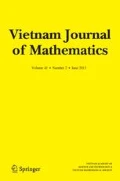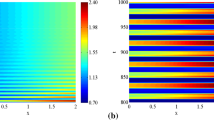Abstract
Physiologically structured population models are typically formulated as a partial differential equation of transport type for the density, with a boundary condition describing the birth of new individuals. Here we develop numerical bifurcation methods by combining pseudospectral approximate reduction to a finite dimensional system with the use of established tools for ODE. A key preparatory step is to view the density as the derivative of the cumulative distribution. To demonstrate the potential of the approach, we consider two classes of models: a size-structured model for waterfleas (Daphnia) and a maturity-structured model for cell proliferation. Using the package MatCont, we compute numerical bifurcation diagrams, like steady-state stability regions in a two-parameter plane and parametrized branches of equilibria and periodic solutions. Our rather positive conclusion is that a rather low dimension may yield a rather accurate diagram! In addition we show numerically that, for the two models considered here, equilibria of the approximating system converge to the true equilibrium as the dimension of the approximating system increases; this last result is also proved theoretically under some regularity conditions on the model ingredients.














Similar content being viewed by others
References
Andò, A., Breda, D.: Collocation techniques for structured populations modeled by delay equations. In: Aguiar, M. et al. (eds.) Current Trends in Dynamical Systems in Biology and Natural Sciences. SEMA SIMAI Springer, vol. 21. Springer (2020)
Andò, A., Breda, D., Scarabel, F.: Numerical continuation and delay equations: A novel approach for complex models of structured populations. Discrete Contin. Dyn. Syst. Ser S. https://doi.org/10.3934/dcdss.2020165 (2019)
Boyd, J.P.: Chebyshev and Fourier Spectral Methods. Dover Books in Mathematics, 2nd edn. Dover Publications, Inc., Mineola (2001)
Breda, D., Diekmann, O., Gyllenberg, M., Scarabel, F., Vermiglio, R.: Pseudospectral discretization of nonlinear delay equations: new prospects for numerical bifurcation analysis. SIAM J. Appl. Dyn. Syst. 15, 1–23 (2016)
Breda, D., Diekmann, O., Liessi, D., Scarabel, F.: Numerical bifurcation analysis of a class of nonlinear renewal equations. Electron. J. Qual. Theory Differ. Equ. 2016, 65 (2016)
Breda, D., Getto, Ph, Sánchez Sanz, J., Vermiglio, R.: Computing the eigenvalues of realistic Daphnia models by pseudospectral methods. SIAM J. Sci. Comput. 37, A2607–A2629 (2015)
Breda, D., Maset, S., Vermiglio, R.: Stability of Linear Delay Differential Equations. A Numerical Approach with MATLAB. SpringerBriefs in Electrical and Computer Engineering. SpringerBriefs in Control, Automation and Robotics. Springer, New York (2015)
Canuto, C., Hussaini, M.Y., Quarteroni, A., Zang Jr, T.A.: Spectral Methods in Fluid Dynamics. Springer Series in Computational Physics. Springer Science & Business Media (2012)
de Roos, A.M.: PSPM analysis. https://bitbucket.org/amderoos/pspmanalysis(2019)
de Roos, A.M., Diekmann, O., Getto, Ph, Kirkilionis, M.A.: Numerical equilibrium analysis for structured consumer resource models. Bull. Math. Biol. 72, 259–297 (2010)
de Roos, A.M., Metz, J.A.J., Evers, E., Leipoldt, A.: A size dependent predator-prey interaction: who pursues whom. J. Math. Biol. 28, 609–643 (1990)
de Roos, A.M., Persson, L.: Population and Community Ecology of Ontogenetic Development. Monographs in Population Biology. Princeton University Press, Oxfordshine (2013)
Dhooge, A., Govaerts, W., Kuznetsov, Yu.A., Meijer, H.G.E., Sautois, B.: New features of the software MatCont for bifurcation analysis of dynamical systems. Math. Comput. Model. Dyn. Syst. 14, 147–175 (2008)
Diekmann, O., Gyllenberg, M., Metz, J.A.J.: On models of physiologically structured populations and their reduction to ordinary differential equations. J. Math. Biol. 80, 189–204 (2020)
Diekmann, O., Gyllenberg, M., Metz, J.A.J.: Steady-state analysis of structured population models. Theor. Popul. Biol. 63, 309–338 (2003)
Diekmann, O., Gyllenberg, M., Metz, J.A.J.: Finite dimensional state representation of linear and nonlinear delay systems. J. Dyn. Differ. Equ. 30, 1439–1467 (2018)
Diekmann, O., Gyllenberg, M., Metz, J.A.J., Nakaoka, S., de Roos, A.M.: Daphnia revisited: Local stability and bifurcation theory for physiologically structured population models explained by way of an example. J. Math. Biol. 61, 277–318 (2010)
Diekmann, O., Scarabel, F., Vermiglio, R.: Pseudospectral discretization of delay differential equations in sun-star formulation: results and conjectures. Discret. Contin. Dyn. Syst. Ser S. https://doi.org/10.3934/dcdss.2020196 (2019)
Diekmann, O., Verduyn Lunel, S.M., van Gils, S.A., Walther, H.-O.: Delay Equations. Functional-, Complex-, and Nonlinear Analysis. Applied Mathematical Sciences, vol. 110. Springer, New York (1995)
Diekmann, O., Verduyn Lunel, S.: Twin semigroups and delay equations. Submitted to J. Diff. Equ. Preprint available at: https://arxiv.org/pdf/1906.03409.pdf (2019)
Doumic, M., Marciniak-Czochra, A., Perthame, B., Zubelli, J.P.: A structured population model of cell differentiation. SIAM J. Appl. Math. 11, 1918–1940 (2011)
Fornberg, B., Sloan, D.M.: A review of pseudospectral methods for solving partial differential equations. Acta Numer. 3, 203–267 (1994)
Funaro, D.: Polynomial Approximation of Differential Equations. Lecture Notes in Physics Monographs, vol. 8. Springer, Berlin (1992)
Getto, Ph, Gyllenberg, M., Nakata, Y., Scarabel, F.: Stability analysis of a state-dependent delay differential equation for cell maturation: Analytical and numerical methods. J. Math. Biol. 79, 281–328 (2019)
Getto, Ph, Waurick, M.: A differential equation with state-dependent delay from cell population biology. J. Differ. Equ. 260, 6176–6200 (2016)
Gyllenberg, M., Scarabel, F., Vermiglio, R.: Equations with infinite delay: Numerical bifurcation analysis via pseudospectral discretization. Appl. Math. Comput. 333, 490–505 (2018)
Hartung, F., Krisztin, T., Walther, H.-O., Wu, J.: Functional differential equations with state-dependent delays: theory and applications. In: Cañada, A., Drábek, P., Fonda, A. (eds.) Handbook of Differential Equations: Ordinary Differential Equations, vol. 3, pp 435–545, North-Holland (2006)
Kooijman, S.A.L.M., Metz, J.A.J.: On the dynamics of chemically stressed populations: The deduction of population consequences from effects on individuals. Ecotoxicol. Environ. Saf. 8, 254–274 (1984)
Krylov, V.I.: Convergence of algebraic interpolation with respect to the roots of Chebyshev’s polynomial for absolutely continuous functions and functions of bounded variation. Dokl. Akad. Nauk SSSR (N.S.) 107, 362–365 (1956). (in Russian)
Marciniak-Czochra, A., Stiehl, T., Ho, A.D., Jäger, W., Wagner, W.: Modeling of asymmetric cell division in hematopoietic stem cells—regulation of self-renewal is essential for efficient repopulation. Stem Cells Dev. 18, 377–386 (2009)
Mastroianni, G., Milovanović, G. V.: Interpolation Processes. Basic Theory and Applications. Springer Monographs in Mathematics. Springer, Berlin (2008)
Metz, J.A.J., Diekmann, O.: The Dynamics of Physiologically Structured Populations. Lecture Notes in Biomathematics, vol. 68. Springer, Berlin (1986)
Perthame, B.: Transport Equations in Biology. Frontiers in Mathematics. Birkhäuser, Basel (2007)
Trefethen, L.N.: Spectral Methods in MATLAB. SIAM, Philadelphia (2000)
Trefethen, L.N.: Approximation Theory and Approximation Practice. SIAM, Philadelphia (2013)
Acknowledgments
The research of FS is funded by NSERC-Sanofi Industrial Research Chair. DB, FS and RV are members of the INdAM Research group GNCS. MG was supported by the Centre of Excellence in Analysis and Dynamics Research, Academy of Finland.
Author information
Authors and Affiliations
Corresponding author
Additional information
Publisher’s Note
Springer Nature remains neutral with regard to jurisdictional claims in published maps and institutional affiliations.
Rights and permissions
About this article
Cite this article
Scarabel, F., Breda, D., Diekmann, O. et al. Numerical Bifurcation Analysis of Physiologically Structured Population Models via Pseudospectral Approximation. Vietnam J. Math. 49, 37–67 (2021). https://doi.org/10.1007/s10013-020-00421-3
Received:
Accepted:
Published:
Issue Date:
DOI: https://doi.org/10.1007/s10013-020-00421-3
Keywords
- Transport equation
- First order partial differential equation
- Size-structured model
- Pseudospectral discretization
- Numerical bifurcation analysis
- Daphnia
- Stem cells
- Equilibria
- Stability boundary
- Hopf bifurcation
- Periodic solutions




